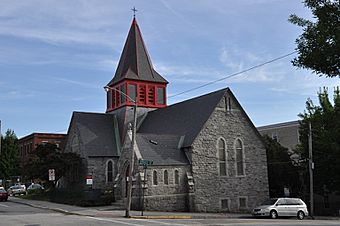Trinity Episcopal Church (Lewiston, Maine) facts for kids
Quick facts for kids |
|
|
Trinity Episcopal Church
|
|
 |
|
| Location | 247 Bates St., Lewiston, Maine |
|---|---|
| Area | less than one acre |
| Built | 1879 |
| Architect | Haight, C. C. Co. |
| Architectural style | Gothic Revival |
| NRHP reference No. | 78000159 |
| Added to NRHP | March 30, 1978 |
Trinity Episcopal Church is a beautiful old church building. You can find it at 247 Bates Street in Lewiston, Maine. It was designed by C.C. Haight from New York City. The church was finished in 1882. It has a special style called Gothic Revival. In 1978, it was added to the National Register of Historic Places. This means it's an important historical place.
Contents
About the Church Building
The Trinity Episcopal Church building is in downtown Lewiston. It is near the corner of Spruce and Bates Streets. The church is made of stone and has a single floor. It is shaped like a cross when you look down from above. The walls are made of granite, and the roof is slate.
A tall, square tower stands in the middle of the church. This tower has a belfry, which is where bells are kept. It also has a pointed roof called a hipped spire. The windows are narrow and pointed, a common feature of Gothic style. Some larger parts of the church have round windows, like a rose.
History of Trinity Church
The Trinity Church group started in 1854. They built their first church building in 1859. It was located on Ash and Park Streets. As more people joined, they needed a bigger space.
The land for the current church was given by the Franklin Company. Building the new church took three years. It was officially opened in 1882.
Trinity Church and the Community
Trinity Church is still a very important part of its neighborhood. In 2001, the church started the Trinity Jubilee Center. This center helps people in need every day. It offers a soup kitchen and other social services.
The Jubilee Center is now its own non-profit group. However, it still operates from inside the church building. The church also helped create other important groups. These include Tree Street Youth and the Center for Wisdom's Women.
Trinity Church also hosts small concerts. It offers support to families who have lost loved ones. They provide memorial services for anyone without a church home. These services are free of charge. The ashes of people who have passed away can be placed in the memorial garden. This garden is right next to the church building.
More Places to Explore



